1. BACKGROUND: AGE OF DEBATE AND FAITH
- Around 6th century BCE, many thinkers and philosophers questioned:
- Rituals and sacrifices in Vedic religion.
- Caste system and authority of Brahmanas.
- Rise of new ideas, sects and philosophies: Buddhism, Jainism, Ajivikas, Charvakas, etc.
2. BUDDHISM
🔹 Gautama Buddha:
- Born in Lumbini (Nepal), Enlightened at Bodh Gaya, first sermon at Sarnath, died at Kushinagar.
- Advocated simple path to salvation through morality and meditation.
🔹 Four Noble Truths (Arya Satya):
- Dukkha – Life is full of suffering.
- Samudaya – Desire causes suffering.
- Nirodha – Ending desire ends suffering.
- Magga – The way to end suffering is the Eightfold Path.
🔹 Eightfold Path (Ashtangik Marg):
- Right View (Samyak Dṛṣṭi)
- Right Intention (Samyak Sankalpa)
- Right Speech (Samyak Vāc)
- Right Action (Samyak Karmānta)
- Right Livelihood (Samyak Ājīva)
- Right Effort (Samyak Vāyāma)
- Right Mindfulness (Samyak Smṛti)
- Right Concentration (Samyak Samādhi)
🔹 Tripitaka (Three Baskets):
- Vinaya Pitaka – Rules for monks and nuns.
- Sutta Pitaka – Teachings and sermons of the Buddha.
- Abhidhamma Pitaka – Philosophical interpretations.
🔹 Sects of Buddhism:
- Hinayana:
- Original sect.
- Believed in individual salvation, no idol worship, language: Pali.
- Mahayana:
- Emerged later.
- Believed in idol worship, Bodhisattvas, language: Sanskrit.
3. JAINISM
🔹 Founder: Vardhaman Mahavira (24th Tirthankara)
- Born in a Kshatriya family in Bihar.
- Attained Kaivalya (omniscience) through meditation.
🔹 Five Vows (Panch Mahavrat):
- Ahimsa – Non-violence
- Satya – Truth
- Asteya – Non-stealing
- Brahmacharya – Celibacy
- Aparigraha – Non-possession
🔹 Key Belief: Anekantavada – multiple truths.
🔹 Sects:
- Digambaras: Sky-clad, no possessions.
- Shvetambaras: White-clad, more liberal.
4. SANGHA – COMMUNITY OF MONKS
- Sangha: Organisation of monks and nuns.
- Rules laid in Vinaya Pitaka.
- Open to all castes and even women (e.g., Mahapajapati Gotami).
- Lived in Viharas, depended on donations (dāna).
5. JATAKA TALES
- Stories of Buddha’s previous lives as human or animal.
- Teachings of morals and ethics.
- Frequently depicted in stupa sculptures, especially at Sanchi.
6. STUPAS – SYMBOLS OF FAITH
🔹 Meaning:
- Mound-like structures built to house relics of Buddha or monks.
🔹 Structure of a Stupa:
- Anda (dome) – symbolizes the world.
- Harmika – Square railing above the dome.
- Yasti – Central mast or axis.
- Chhatra – Umbrella for protection.
- Vedika – Stone railings surrounding the stupa.
- Torana – Ornamental four gateways at cardinal directions.
7. SANCHI STUPA
- Built by Ashoka, enlarged later by Shungas and Satavahanas.
- Toranas (gateways) depict:
- Jataka stories
- Life of Buddha through symbols (e.g., tree for enlightenment, wheel for dharma)
- Donor inscriptions (including common people, women, merchants).
8. AMARAVATI STUPA
- Located in Andhra Pradesh.
- Larger and richer than Sanchi.
- Narratives more elaborate and fluid.
- Many sculptures taken to British Museum, leading to its ruin over time.
9. ROLE OF BHOPAL BEGUMS IN SAVING SANCHI STUPA
- In the 19th century, Sanchi was in ruins.
- Begum Shah Jahan of Bhopal and Sultan Jahan Begum:
- Funded excavation, fencing, restoration.
- Supported ASI work and conservation.
- Promoted building a museum to preserve findings.
10. JOHN MARSHALL’S CONTRIBUTION
- Director-General of ASI (1902–1928).
- Initiated scientific conservation at Sanchi and other sites.
- Involved local population in heritage protection.
- Published documentation of monuments with illustrations and photos.
11. SOURCES OF INFORMATION
| Source | Example |
|---|---|
| Texts | Tripitaka, Jain Agamas, Jataka tales |
| Inscriptions | Donor names on railings |
| Sculptures | Sanchi, Amaravati |
| Accounts | Chinese pilgrims (Fa-Hien, Hiuen Tsang) |
CBSE Exam-Focused Topics to Prepare
- Difference between Mahayana and Hinayana
- Features of Sanchi Stupa
- Symbols used for Buddha in sculpture
- Contribution of Bhopal Begums
- John Marshall’s role in archaeology
- Structure and significance of a stupa
- What do Jataka tales reveal?
- Panch Mahavrat and Ashtangik Marg








is this enough for wrote in exam